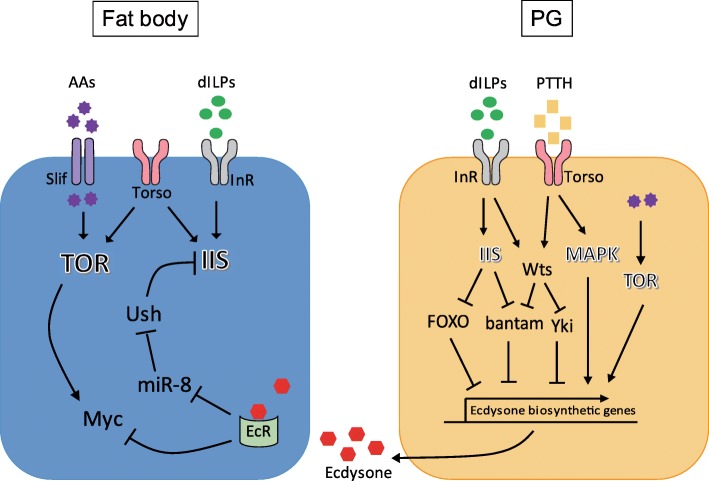Fig. 1.
The outline of the molecular pathways in the fat body and prothoracic gland (PG) implicated in ecdysone-mediated body growth and size determination. In the fat body, amino acids (AAs) transported via the Slimfast (Slif) transporter stimulate the activity of target of rapamycin (TOR) signaling. Drosophila insulin-like peptides (dILPs) bind to and activate the insulin receptor (InR), thereby increasing the activity of the insulin/insulin-like growth factor signaling (IIS) pathway. Activation of the ecdysone receptor (EcR) by ecdysone binding inhibits the expression of miR-8, thereby activating the expression of U-shaped (Ush), an inhibitor of IIS. Activated EcR also represses Myc, activated by TOR signaling. Through these pathways, ecdysone suppresses IIS/TOR activity, thereby attenuating the rate of body growth. In the PG, activated IIS suppresses bantam, a repressor of the expression of ecdysone biosynthetic genes. FOXO, which is suppressed by IIS, binds to ultraspiracle (Usp) thereby inhibiting the expression ecdysone biosynthetic genes. PTTH peptides released from the axon terminals of PTTH-expressing neurons acts on Torso, the PTTH receptor, which activates MAPK signaling cascades, thereby activating ecdysone generation. Activated InR or Torso also stimulates Warts (Wts), which in turn represses the activity of bantam and Yorki (Yki), thereby controlling ecdysone synthesis. TOR signaling activated by a protein-rich diet promotes ecdysone generation. Torso is also expressed in the fat body, stimulating IIS/TOR. The ligands acting on Torso in the fat body are currently unknown

